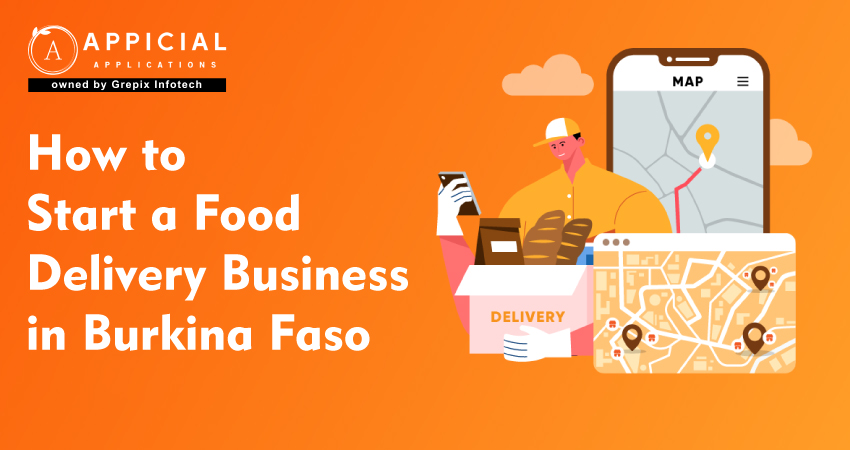
How to Start a Food Delivery Business in Burkina Faso
Walk through Ouagadougou on a Saturday evening and you’ll notice two things: the smell of grilled chicken drifting through the air, and the number of people waiting for takeaway orders outside small restaurants. It’s not just street food vendors anymore. New cafés, pizzerias, and fast-food joints are popping up every few months.
The demand for convenience is shifting habits. People want their favorite meals without leaving home. In other countries, this has already transformed into massive platforms like Uber Eats Delivery, Grubhub Delivery, and DoorDash Food Delivery.
In Burkina Faso, the wave is just beginning. This means there’s space for local entrepreneurs to Create Food Delivery App solutions designed for real local challenges like mobile money payments, motorbike-friendly delivery routes, and dishes that don’t survive a 40-minute ride unless packed right.
The same opportunity is present in Burkina Faso. Local entrepreneurs can adapt proven models to fit the country’s payment methods, road networks, and consumer preferences. With the right planning and a skilled Food App Development Company, it’s possible to create Food Delivery App systems that thrive even in a developing market.
A full guide for launching a Food Delivery App in Burkina Faso, from market trends to features, tech stack, costs, and gaps. It explains how to adapt Grubhub Delivery, Uber Eats Delivery, and DoorDash Food Delivery models to local realities and why partnering with a Food App Development Company like Appicial increases success chances.
Why Invest in Food Delivery App Development in Burkina Faso?
Here’s the thing! A Food Delivery App isn’t just about tech. It’s about matching tech to daily life. And right now, Burkina Faso has a few factors lining up perfectly.
- Urban growth: Ouagadougou has passed 3 million residents, and Bobo-Dioulasso is growing steadily. More people, more restaurants, more orders.
- Mobile-first behavior: Most users go online through their phones. That makes an Online Food Delivery App a natural fit.
- Competition gap: There’s no dominant Food Delivery platform yet. Whoever builds trust first can set the standard.
Take an example—if just 2% of Ouagadougou’s middle-income households use a delivery service once a week, that’s tens of thousands of transactions monthly. A platform modeled on DoorDash Delivery App or Grubhub food delivery but adapted for local payment systems could own that market segment quickly.
What are the Must-Have Features for a Food Delivery App?
Not every feature from Uber Eats Delivery will make sense here. But a few are essential:
For customers:
- Clean menu browsing. People should find “riz gras” or “brochettes” as easily as pizza.
- Custom orders (extra sauce, no onions).
- Multiple payment options, including cash on delivery, Orange Money, Moov Money, and cards for the expat crowd.
- Order tracking. Not everyone will watch the map, but it builds trust.
- Order history for quick reordering.
For restaurants:
- Easy menu updates. Many change their menus daily.
- Notifications for new orders.
- A simple way to mark items as “out of stock.”
For couriers:
- GPS navigation with options for traffic avoidance.
- Order batching for efficiency.
For admins:
- Commission settings.
- Promo codes and free delivery campaigns.
- Customer service dashboard.
These basics make a platform competitive, even if the Food Delivery App starts with a small pool of restaurants.
Technology Stack and Architecture
Now, a quick note! Rech decisions matter because scaling later can be expensive if the base isn’t solid.
- Frontend: Flutter or React Native (works on both iOS and Android without double development cost).
- Backend: Node.js or Django for speed and scalability.
- Database: PostgreSQL or MongoDB for reliability.
- Tracking: Google Maps API or OpenStreetMap for low-cost mapping.
- Payments: APIs for Orange Money, Moov Money, and local bank cards.
A strong Food App Development Company will set this up so it can grow from a 20-restaurant trial in Ouagadougou to a multi-city Build Food Delivery App operation without starting over.
What are the Challenges and Market Gaps in Burkina Faso?
Let’s not pretend it’s all smooth.
- Delivery addresses: Many streets have no formal names. The app must allow pin-drop locations or landmark-based notes.
- Payment habits: People trust cash. That’s fine, but it means your couriers become part of cash handling.
- Weather: In the rainy season, delays are normal. You need contingency planning in your Online Food Delivery App.
- Restaurant readiness: Some kitchens move slowly. Delivery works best when prep times are predictable.
On the upside, there’s a huge gap in late-night delivery. If your platform delivers hot food after 10 PM, you might corner a market segment that DoorDash Food Delivery and Grubhub Delivery dominate in other countries.
Estimated Development Cost & Timeline
Let’s get specific.
- Basic app with essential features: CFA 9–15 million.
- Mid-tier with advanced tracking and analytics: CFA 20–35 million.
- Premium with multi-city, full customization, and marketing tools: CFA 40–55 million+.
Timeline:
- Planning: 3–5 weeks.
- Development: 10–14 weeks.
- Testing & launch: 3–4 weeks.
With 1,500 monthly orders at an average CFA 3,000 value and 20% commission, that’s CFA 900,000 revenue just from commissions. Add delivery fees and scaling to 5,000 orders, and you could hit CFA 3 million monthly.
How Appicial Applications Can Help?
Appicial Applications specializes in Food App Development Company services for emerging markets. Their approach includes:
- Local market adaptation: Payment integrations for Orange Money, Moov Money, and local banks.
- Scalable design: Systems that can evolve from a small pilot in Ouagadougou to a multi-city Food Delivery App network.
- Custom branding: Unique interfaces so platforms stand out from generic Food Delivery Platforms.
- End-to-end development: From initial concept to Build Food Delivery App deployment and ongoing updates.
- Performance optimization: Ensuring apps handle peak order hours without lag.
Their team has experience adapting models similar to Grubhub Delivery, DoorDash Food Delivery, and Uber Eats Delivery to African market realities.
Conclusion
Burkina Faso’s food delivery scene is a blank canvas. With a thoughtful Food Delivery App, there’s room to dominate before big global players arrive.
The model works. The technology is accessible. The market is ready for a localized Build Food Delivery App approach that understands both tech and street-level logistics.
Partnering with the right Food App Development Company could mean going from idea to a fully operational Online Food Delivery App in under six months and becoming the go-to name in urban convenience. We have a dedicated team of food delivery app development experts who build performance-rich, scalable, and tech-driven apps that not just engage but drive tangible business results in the long run.
FAQs
Author's Bio

Vinay Jain is the Founder at Grepix Infotech and brings over 12 years of entrepreneurial experience. His focus revolves around software & business development and customer satisfaction.
Back to blog list





